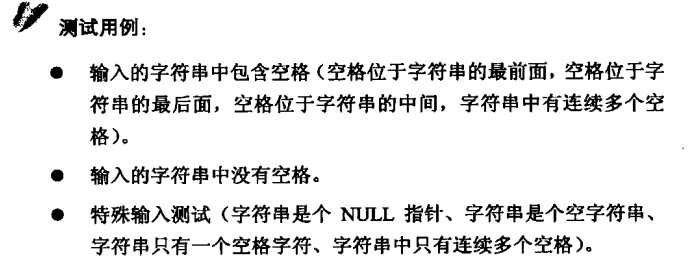《剑指Offer》面试题4:替换空格
题目描述
请实现一个函数,把字符串中的每个空格替换成“%20”。例如输入“We are happy.”,则输出“We%20are%20happy.”。
解题思路
测试用例
代码
/*《剑指Offer——名企面试官精讲典型编程题》代码
著作权所有者:何海涛*/
#include "stdio.h"
#include <string>
/*length 为字符数组string的总容量*/
void ReplaceBlank(char string[], int length)
{
if (string == NULL && length <= 0)
return;
/*originalLength 为字符串string的实际长度*/
int originalLength = 0;
int numberOfBlank = 0;
int i = 0;
while (string[i] != '\0')
{
++originalLength;
if (string[i] == ' ')
++numberOfBlank;
++i;
}
/*newLength 为把空格替换成'%20'之后的长度*/
int newLength = originalLength + numberOfBlank * 2;
if (newLength > length)
return;
int indexOfOriginal = originalLength;
int indexOfNew = newLength;
while (indexOfOriginal >= 0 && indexOfNew > indexOfOriginal)
{
if (string[indexOfOriginal] == ' ')
{
string[indexOfNew--] = '0';
string[indexOfNew--] = '2';
string[indexOfNew--] = '%';
}
else
{
string[indexOfNew--] = string[indexOfOriginal];
}
--indexOfOriginal;
}
}
void Test(char* testName, char string[], int length, char expected[])
{
if (testName != NULL)
printf("%s begins: ", testName);
ReplaceBlank(string, length);
if (expected == NULL && string == NULL)
printf("passed.\n");
else if (expected == NULL && string != NULL)
printf("failed.\n");
else if (strcmp(string, expected) == 0)
printf("passed.\n");
else
printf("failed.\n");
}
// 空格在句子中间
void Test1()
{
const int length = 100;
char string[length] = "hello world";
Test("Test1", string, length, "hello%20world");
}
// 空格在句子开头
void Test2()
{
const int length = 100;
char string[length] = " helloworld";
Test("Test2", string, length, "%20helloworld");
}
// 空格在句子末尾
void Test3()
{
const int length = 100;
char string[length] = "helloworld ";
Test("Test3", string, length, "helloworld%20");
}
// 连续有两个空格
void Test4()
{
const int length = 100;
char string[length] = "hello world";
Test("Test4", string, length, "hello%20%20world");
}
// 传入NULL
void Test5()
{
Test("Test5", NULL, 0, NULL);
}
// 传入内容为空的字符串
void Test6()
{
const int length = 100;
char string[length] = "";
Test("Test6", string, length, "");
}
//传入内容为一个空格的字符串
void Test7()
{
const int length = 100;
char string[length] = " ";
Test("Test7", string, length, "%20");
}
// 传入的字符串没有空格
void Test8()
{
const int length = 100;
char string[length] = "helloworld";
Test("Test8", string, length, "helloworld");
}
// 传入的字符串全是空格
void Test9()
{
const int length = 100;
char string[length] = " ";
Test("Test9", string, length, "%20%20%20");
}
int main()
{
Test1();
Test2();
Test3();
Test4();
Test5();
Test6();
Test7();
Test8();
Test9();
system("pause");
return 0;
}
相关题目
有两个排序数组A1和A2,内存在A1的末尾有足够多的空余空间容纳A2,实现一个函数,把A2中的所有数字插入到A1中并且所有的数字是排序的。
#include <iostream>
using namespace std;
void MerageArray(int *a1, int *a2, int a1Length, int a2Length, int a1Volume)
{
//两个排序的数组a1和a2,它们的实际长度a1Length和a2Length,a1Volume为a1的总容量
int merageLength = a1Length + a2Length; //合并两个数组后的实际长度
//边界检查
if (!a1 || !a2 || merageLength > a1Volume ||
a1Length <= 0 || a2Length <= 0)
{
return;
}
int index = merageLength - 1; //用来指向a1或a2中元素要被复制到的位置
int a1Index = a1Length - 1; //指向a1中要复制元素的位置
int a2Index = a2Length - 1;//指向a2中要复制元素的位置
while (index >= 0 && a1Index >= 0 && a2Index >= 0)
{
//将两个数组中较大的元素复制
if (a1[a1Index] > a2[a2Index])
{
a1[index] = a1[a1Index];
a1Index--;
}
else
{
a1[index] = a2[a2Index];
a2Index--;
}
index--;
}
//当数组a1中的元素已复制完,但数组a2仍有元素,则将其依次复制到a1中
while (index >= 0 && a2Index >= 0)
{
a1[index] = a2[a2Index];
index--;
a2Index--;
}
}
int main()
{
int a[10] = { 12, 13, 14, 15 };
int b[6] = { 1, 4, 5, 9, 10 };
int len1 = 4;
int len2 = 5;
MerageArray(a, b,len1,len2,10);
for (int i = 0; i<len1 + len2; i++)
{
cout << a[i] << " ";
}
system("pause");
return 0;
}



